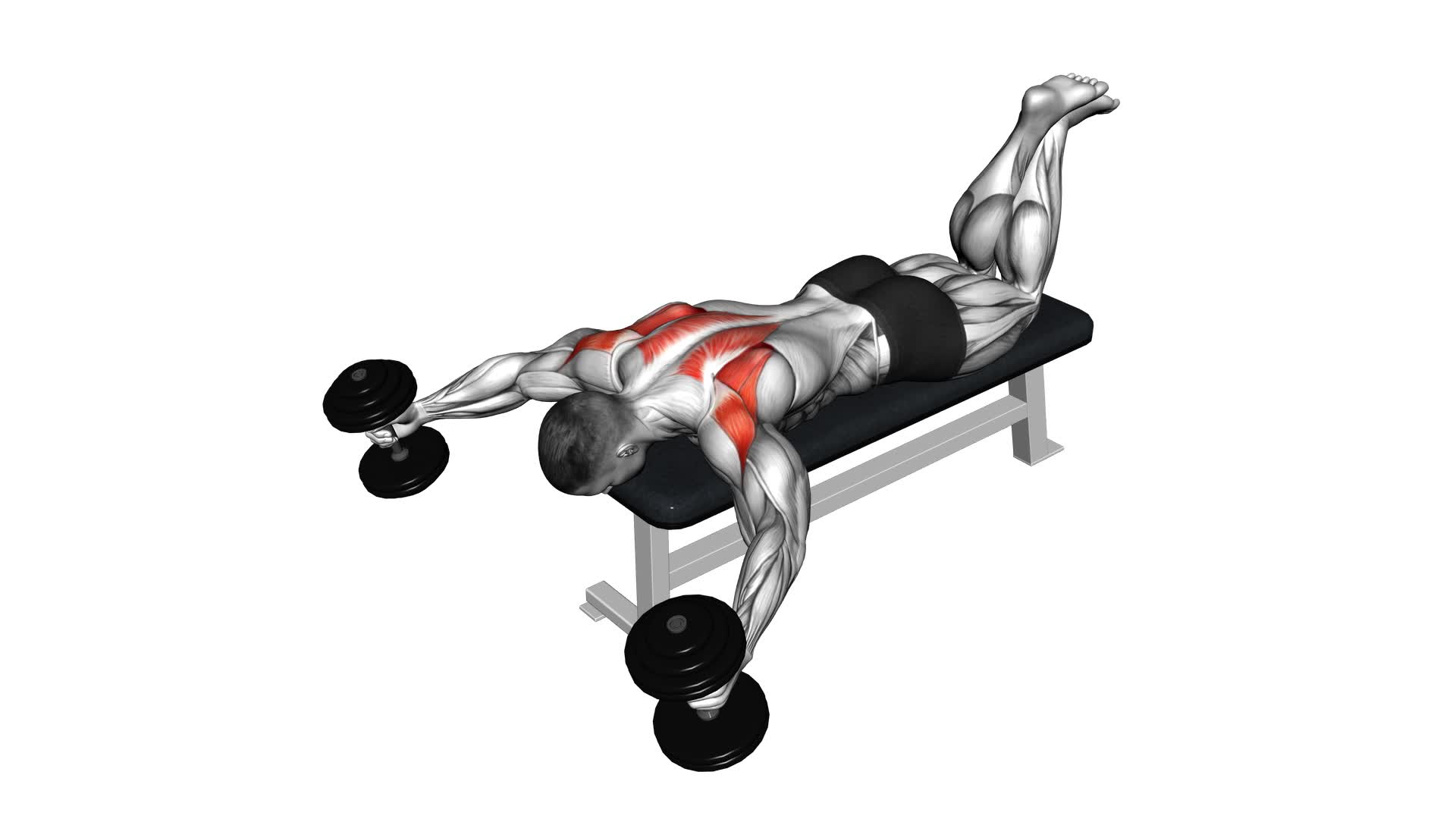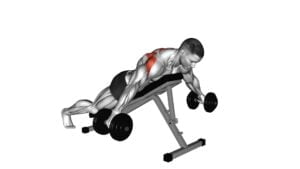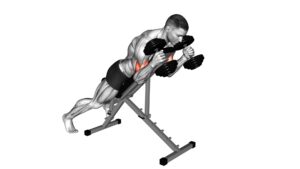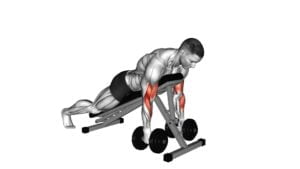Dumbbell Prone Full Can Exercise (male) – Video Exercise Guide & Tips

Looking to tone your upper body?
Watch This Exercise Video
Try the dumbbell prone full can exercise!
This video exercise guide and tips will show you how to perform this effective exercise correctly.
Increase the difficulty with variations and avoid common mistakes.
Maximize your results with these helpful tips.
Get ready to feel the burn and achieve your fitness goals!
Key Takeaways
- Targets and strengthens shoulder muscles
- Improves stability and range of motion
- Enhances muscle activation and prevents injuries
- Strengthens muscles around the shoulder blades for proper posture
Benefits of Dumbbell Prone Full Can Exercise
The dumbbell prone full can exercise is a highly effective exercise that targets and strengthens your shoulder muscles, while also improving your overall stability and range of motion. This exercise is particularly beneficial for muscle activation and injury prevention.
When performing the dumbbell prone full can exercise, you lie face down on a bench or stability ball, holding a dumbbell in each hand. You then raise your arms out to the sides, keeping them straight, until they're parallel to the floor. This movement engages your shoulder muscles, specifically the rotator cuff muscles, which play a crucial role in stabilizing the shoulder joint.
By regularly incorporating this exercise into your workout routine, you can enhance the activation of these muscles, leading to improved shoulder stability and reduced risk of injuries. The dumbbell prone full can exercise also helps to strengthen the muscles surrounding your shoulder blades, which further contributes to injury prevention by promoting proper posture and alignment.
Additionally, this exercise enhances your range of motion in the shoulder joint, allowing for better mobility and flexibility. This can be particularly beneficial for athletes or individuals involved in activities that require a wide range of shoulder movements, such as throwing or overhead lifting.
Proper Form and Technique
Maintain proper form and technique while performing the dumbbell prone full can exercise to maximize its benefits and minimize the risk of injury. Here are some tips to help you achieve the correct form:
- Lie face down on a flat bench with your arms extended straight out in front of you, holding a dumbbell in each hand. Keep your palms facing down.
- Engage your core and squeeze your shoulder blades together as you lift the dumbbells up towards the ceiling, maintaining a slight bend in your elbows.
- As you lift, imagine pouring water out of a can, bringing your thumbs up towards the ceiling. This movement targets the muscles in your rotator cuff and upper back.
- Slowly lower the dumbbells back down to the starting position, maintaining control throughout the entire motion.
Now that you know the proper form, it's important to address some common misconceptions and injury prevention techniques.
One common misconception is that you need to lift heavy weights to see results. However, using lighter weights with proper form can be just as effective and reduce the risk of straining or injuring your muscles.
To prevent injury, always warm up before exercising and listen to your body. If you experience any pain or discomfort, stop immediately and consult a professional.
Variations for Increased Difficulty
To increase the difficulty of the dumbbell prone full can exercise, you can incorporate variations into your routine. These variations will help you achieve progressive overload and challenge your muscles in new ways.
One advanced modification you can try is using heavier dumbbells. By increasing the weight, you'll put more strain on your muscles, forcing them to work harder and adapt to the increased load.
Another option is to perform the exercise on an unstable surface, such as a stability ball or a balance board. This will engage your core muscles even more as they work to stabilize your body during the movement.
Additionally, you can try performing the exercise with one arm at a time, which will further challenge your stability and require more control.
Lastly, you can experiment with different tempos and ranges of motion. Try slowing down the movement or increasing the range of motion to intensify the exercise.
Remember to always listen to your body and progress gradually to avoid injury.
Incorporating these advanced modifications will take your dumbbell prone full can exercise to the next level and help you achieve your fitness goals.
Common Mistakes to Avoid
To avoid common mistakes during the dumbbell prone full can exercise, it's important to focus on proper form and technique. Here are four common mistakes to avoid:
- Arching your back: Keep your spine neutral throughout the exercise. Avoid arching or rounding your back, as this can put unnecessary strain on your spine.
- Lifting too heavy: It's crucial to choose a weight that allows you to maintain proper form throughout the movement. Lifting too heavy can compromise your technique and increase the risk of injury.
- Allowing your shoulders to shrug: Keep your shoulders down and away from your ears during the exercise. Shruging your shoulders can lead to tension in the neck and upper traps, detracting from the effectiveness of the exercise.
- Raising your arms too high: When performing the full can motion, it's important to stop when your arms reach shoulder level. Raising them too high can place excessive stress on the shoulder joint.
Tips for Maximizing Results
To get the most out of your dumbbell prone full can exercise, focus on these tips for maximizing your results.
First and foremost, staying motivated is key to achieving your fitness goals. Set specific and attainable goals for yourself, and track your progress along the way. Reward yourself for reaching milestones, whether it's treating yourself to a new workout outfit or indulging in a healthy meal at your favorite restaurant.
In addition to staying motivated, paying attention to your nutrition is crucial for maximizing your results. Fuel your body with the right nutrients to support muscle growth and recovery. Prioritize lean proteins, such as chicken, fish, and tofu, which provide the building blocks for muscle repair. Incorporate plenty of fruits and vegetables for vitamins, minerals, and antioxidants. Stay hydrated by drinking enough water throughout the day, especially before and after your workouts.
Remember to listen to your body and give yourself enough rest and recovery. Overtraining can hinder your progress and increase the risk of injury. Aim for at least seven to eight hours of sleep each night to allow your muscles to repair and recharge.
Frequently Asked Questions
How Many Sets and Reps Should I Do for the Dumbbell Prone Full Can Exercise?
For the dumbbell prone full can exercise, the number of sets and reps can vary depending on your fitness level and goals. As a general guideline, you can start with 2-3 sets of 8-12 reps.
This exercise targets your shoulder muscles and can help improve strength and stability. Make sure to choose a weight that challenges you but still allows you to maintain proper form.
As you progress, you can increase the number of sets or reps or try different variations of the exercise to keep challenging your muscles.
Can I Use Resistance Bands Instead of Dumbbells for This Exercise?
Yes, you can definitely use resistance bands instead of dumbbells for the prone full can exercise. Using resistance bands adds variety to your workout routine and can provide different levels of resistance.
This exercise targets the muscles in your shoulders and upper back, helping to improve stability and posture.
Incorporating resistance bands into your routine can also help to strengthen your muscles in different ways, enhancing overall muscle development.
Is It Necessary to Warm up Before Performing This Exercise?
Before performing any exercise, it's necessary to warm up. Warming up helps increase blood flow to your muscles, making them more flexible and less prone to injury. It also prepares your body for the upcoming workout by raising your heart rate and increasing your body temperature.
When performing the dumbbell prone full can exercise, it's important to avoid common mistakes like using excessive weight or arching your back. Always start with a proper warm-up to maximize the benefits and minimize the risks.
Can I Do This Exercise if I Have a Shoulder Injury?
If you have a shoulder injury, it's important to consider recovery options before attempting the Dumbbell Prone Full Can Exercise.
Consult with a healthcare professional or physical therapist for guidance on exercises that are suitable for your condition. They can provide alternative exercises that will help strengthen your shoulder without causing further harm.
Remember to always prioritize your health and safety when exercising.
Can I Incorporate This Exercise Into My Current Workout Routine?
Yes, you can incorporate this exercise into your current workout routine.
By incorporating this exercise, you can target and strengthen your shoulder muscles.
However, it's important to modify your workout routine and consult with a professional if you have a shoulder injury.
They can provide guidance on proper form and ensure that you aren't aggravating your injury.
Remember to start with lighter weights and gradually increase as you become more comfortable and your shoulder strength improves.
Conclusion
In conclusion, the dumbbell prone full can exercise is a beneficial exercise for males. It helps improve shoulder strength and stability, and can be easily modified to increase difficulty.
By maintaining proper form and technique, avoiding common mistakes, and following these tips, you can maximize your results.
Incorporating this exercise into your fitness routine can lead to stronger and more stable shoulders.

Author
Years ago, the spark of my life’s passion ignited in my mind the moment I stepped into the local gym for the first time. The inaugural bead of perspiration, the initial endeavor, the very first surge of endorphins, and a sense of pride that washed over me post-workout marked the beginning of my deep-seated interest in strength sports, fitness, and sports nutrition. This very curiosity blossomed rapidly into a profound fascination, propelling me to earn a Master’s degree in Physical Education from the Academy of Physical Education in Krakow, followed by a Sports Manager diploma from the Jagiellonian University. My journey of growth led me to gain more specialized qualifications, such as being a certified personal trainer with a focus on sports dietetics, a lifeguard, and an instructor for wellness and corrective gymnastics. Theoretical knowledge paired seamlessly with practical experience, reinforcing my belief that the transformation of individuals under my guidance was also a reflection of my personal growth. This belief holds true even today. Each day, I strive to push the boundaries and explore new realms. These realms gently elevate me to greater heights. The unique combination of passion for my field and the continuous quest for growth fuels my drive to break new ground.







